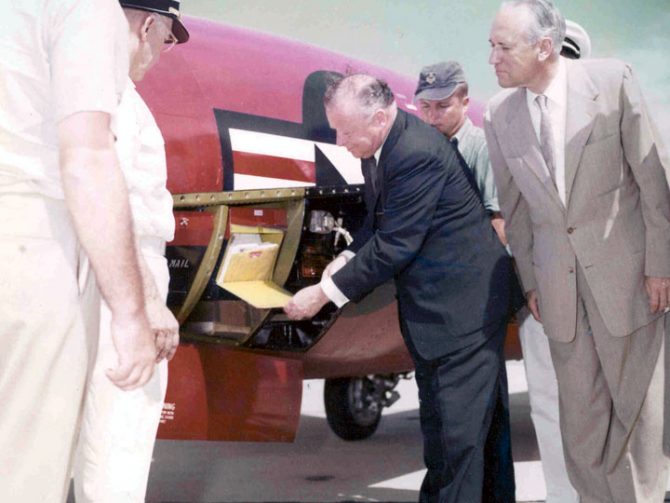 Throughout its history, the Postal Service has explored faster, more efficient forms of mail transportation. Technologies now commonplace – railroads, automobiles, and airplanes – were embraced by the Post Office Department at their radical birth, when they were considered new-fangled, unworkable contraptions by many. One such technology, however, remains only a footnote in the history of mail delivery – missile mail.
Throughout its history, the Postal Service has explored faster, more efficient forms of mail transportation. Technologies now commonplace – railroads, automobiles, and airplanes – were embraced by the Post Office Department at their radical birth, when they were considered new-fangled, unworkable contraptions by many. One such technology, however, remains only a footnote in the history of mail delivery – missile mail.
On June 8, 1959, in a move that Postmaster General Arthur A. Summerfield heralded as “of historic significance to the peoples of the entire world,” the Navy submarine USS Barbero fired a guided missile carrying 3,000 letters towards the naval auxiliary air station in Mayport, Florida.
Racing along at about 600 miles per hour, the guided missile traveled the more than 100 miles from the deck of the submarine off the coast of Florida to the air station in about 22 minutes. The letters, in special commemorative envelopes, were all from the Postmaster General to leading government officials and prominent citizens with a special interest in the Post Office Department.
“Before man reaches the moon,” Summerfield was quoted as saying, “mail will be delivered within hours from New York to California, to England, to India or to Australia by guided missiles.”
History proved differently, but this experiment with missile mail exemplifies the pioneering spirit of the Post Office Department when it came to developing faster, better ways of moving the mail.
The 1959 event was widely-publicized as the “first official missile mail” to distinguish it from earlier rocket flights. The earliest known unofficial transportation by rocket of U.S. Mail took place on February 23, 1936, when two rockets transported mail about 2,000 feet across a frozen lake towards the Hewitt, New Jersey, Post Office, from Greenwood Lake, New York. The rockets crash-landed before reaching their destination and slid along the ice; the postmaster of Hewitt obliged by removing the two bags of mail and dragging them the rest of the way to the Post Office.



